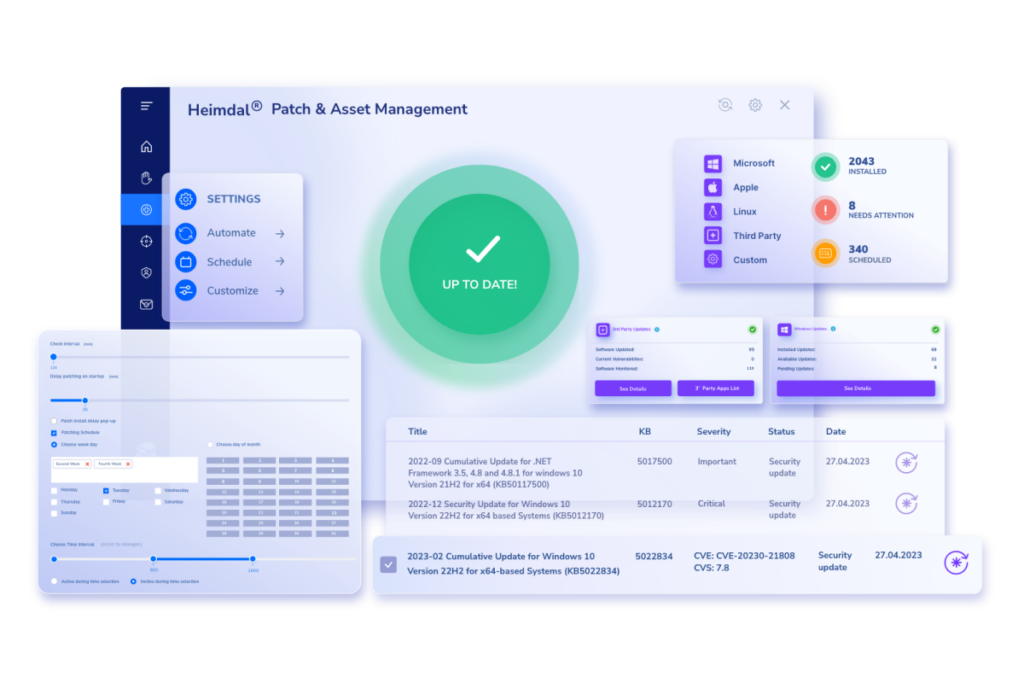Contents:
Keeping Windows applications up to date is a challenge, and Patch My PC seems to be a favorite for automating the process. Some of its users praise the solution’s lightweight agent and strong third-party app support.
However, this tool also has its downsides:
- a reviewer on G2 says that only one user can be in the application at a time.
- reporting isn’t built into the tool—it has to be set up manually. Also, for now, Patch My PC doesn’t offer reporting for Intune deployments. This can be very inconvenient for companies under NIS2, DORA, or HIPAA compliance regulations.
So, you might want to look for Patch My PC alternatives that offer more features, better pricing, or cross-platform patching. Here’s a list of the 10 best Patch My PC competitors to check out.
Key takeaways:
- Heimdal Patch & Asset Management – Offers cross-platform patching (Windows, macOS, Linux) with secure, automated updates for over 350 apps.
- Action1 – Cloud-based solution ideal for remote teams, with real-time vulnerability detection and compliance reporting.
- PDQ Deploy & Inventory – Fast and user-friendly patching tool focused solely on Windows environments.
- Automox – Cloud-native platform with AI-driven patch automation across Windows, macOS, and Linux.
- ManageEngine Patch Manager Plus – Supports extensive third-party app patching and includes built-in vulnerability scanning.
- Tenable Nessus – Advanced vulnerability assessment tool that prioritizes risks but requires separate patching tools.
- NinjaOne – Unified IT management platform with automated patching and remote monitoring capabilities.
- SecOps Solution – Agentless patch management that prioritizes patches based on threat intelligence.
- Atera – All-in-one IT management suite with integrated patching, automation, and helpdesk tools.
- Barracuda RMM – MSP-focused platform combining patching with built-in antivirus and security-first features.
What makes Heimdal the best Alternative to Patch My PC?
Heimdal’s Patch & Asset Management solution covers Windows, macOS, and Linux environments—unlike Patch My PC, which only supports Windows. It also manages updates for over 350+ third-party applications, compared to Patch My PC’s 148 supported apps.
Additionally, Heimdal’s solution:
- Requires minimal bandwidth resources by using peer-to-peer (P2P) patch distribution.
- Encrypts updates with HTTPS, ensuring secure delivery.
- Automates patching across distributed teams, whether they’re remote, hybrid, or on-premises.
- Delivers patches in under four hours, including testing and deployment.
What do our customers say?
Heimdal’s patching and deployment software is the easiest and most flexible solution we have used so far. I like the fact that it can do deployment and update of Microsoft and 3rd party software but also our own in-house, which is rare to find. We use its automation features with scheduling and can deploy to our employees anywhere they are, which is also a great benefit because our employees are 80% of the time working remotely.
Main capabilities
- Cross-platform patching (Windows, macOS, Linux).
- Automated third-party application updates for 350+ apps.
- Encrypted HTTPS patch delivery for security.
- Flexible policy customization with centralized management.
Pricing
Heimdal offers customized pricing that fits various business requirements and usage patterns. To see Heimdal in action watch the video below and book a custom demo.
-
Action1
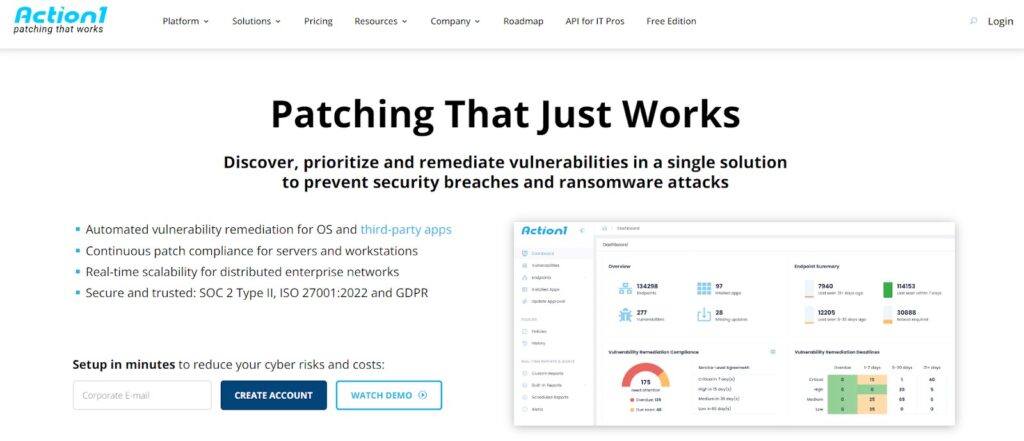 Action1 is a cloud-based patch management software designed for IT teams managing remote and hybrid workforces. It offers real-time vulnerability detection and automated patch deployment.
Action1 is a cloud-based patch management software designed for IT teams managing remote and hybrid workforces. It offers real-time vulnerability detection and automated patch deployment.
Main capabilities
- Cloud-based patching with remote management.
- Automated third-party software updates.
- Detailed compliance reporting.
- Zero-touch deployment for security updates.
Cons
- Lacks on-premises deployment options.
- No easy way to uninstall bad patches.
Our main concern is how to uninstall patches deployed with Action1 in the event that a bad patch is released – there is no easy way to pull back a patch via Action1.
Pricing
Pricing is not publicly listed, but Action1 offers a free tier for small teams, with paid plans based on endpoint volume.
-
PDQ Deploy & Inventory
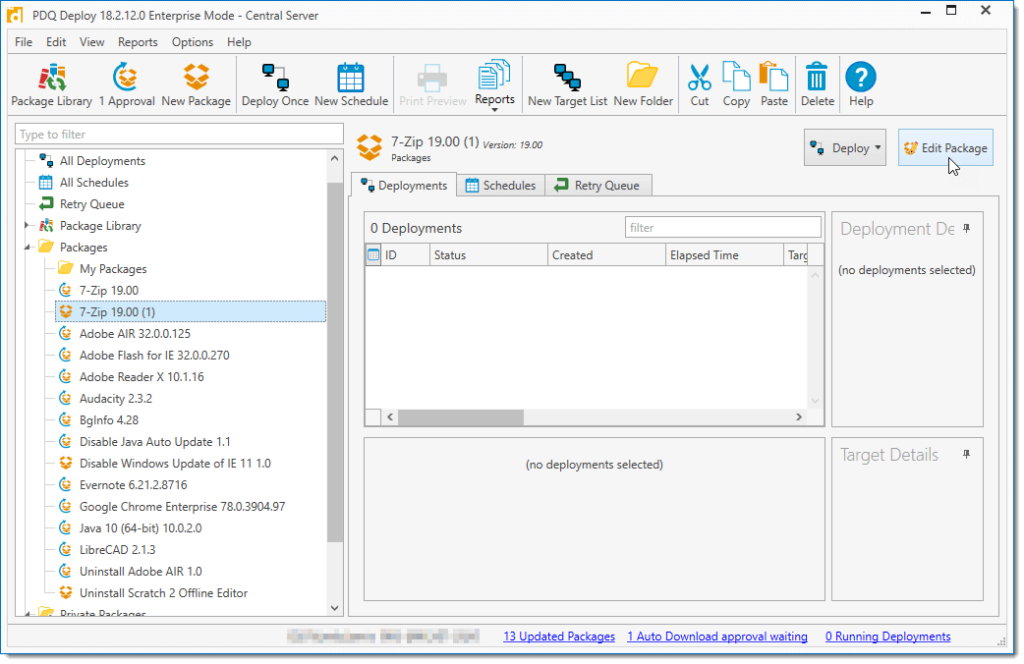
PDQ Deploy is a Windows-focused patch management tool known for its fast software deployment and easy-to-use interface. It is one of the most appreciated patching solutions and you can read more about it in this PDQ alternatives article.
Main capabilities
- Automated patch deployment for Windows apps.
- Real-time inventory tracking.
- Customizable deployment schedules.
Cons
- No support for macOS or Linux.
- Lacks cloud-based management.
Pricing
Pricing starts at $1,500 per admin per year, with additional costs for enterprise features.
-
Automox

Automox is a cloud-native patch management solution that automates OS and third-party application updates. It offers a unified dashboard for all the processes, no matter how many OSs and third-party apps you need to patch.
Main capabilities
- Cross-platform support (Windows, macOS, Linux).
- Patch automation with AI-powered recommendations.
- Zero-touch remote deployment.
Cons
- Some users report occasional patch failures.
- Higher price compared to competitors.
Automox’s pricing can become expensive when scaling, especially considering its limited feature set compared to competitors.
Pricing
Pricing starts at $3 per endpoint per month, with custom pricing for large enterprises.
-
ManageEngine Patch Manager Plus
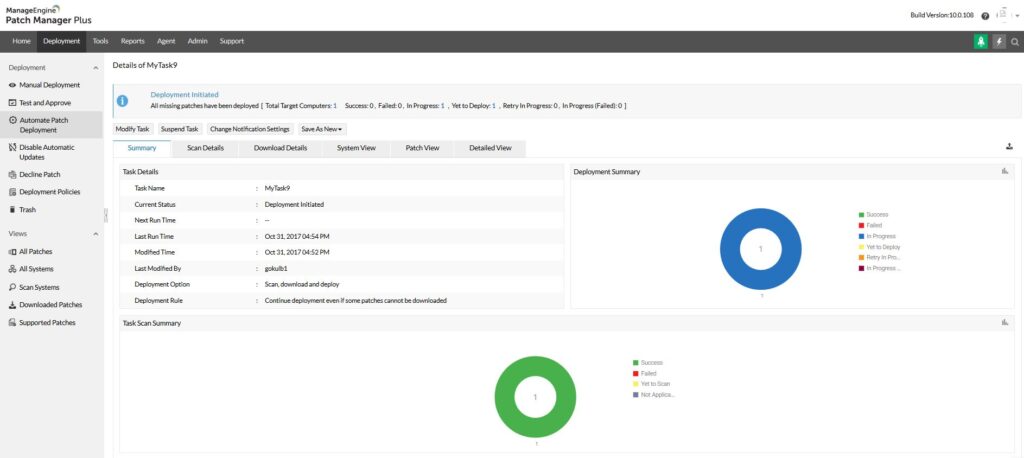
ManageEngine provides on-premises and cloud-based patching with extensive automation features. The solution automates the patch management process, ensuring businesses can maintain compliance and reduce security risks without manual intervention.
Main capabilities
- Patch deployment across Windows, macOS, and Linux.
- Third-party app patching for 900+ applications.
- Integrated vulnerability scanning.
Cons
- Complex UI with a steep learning curve.
- Users reported patch delays for large deployments.
Pricing
Starts at $245 per 50 endpoints per year, with tiered pricing for enterprises.
-
Tenable Nessus
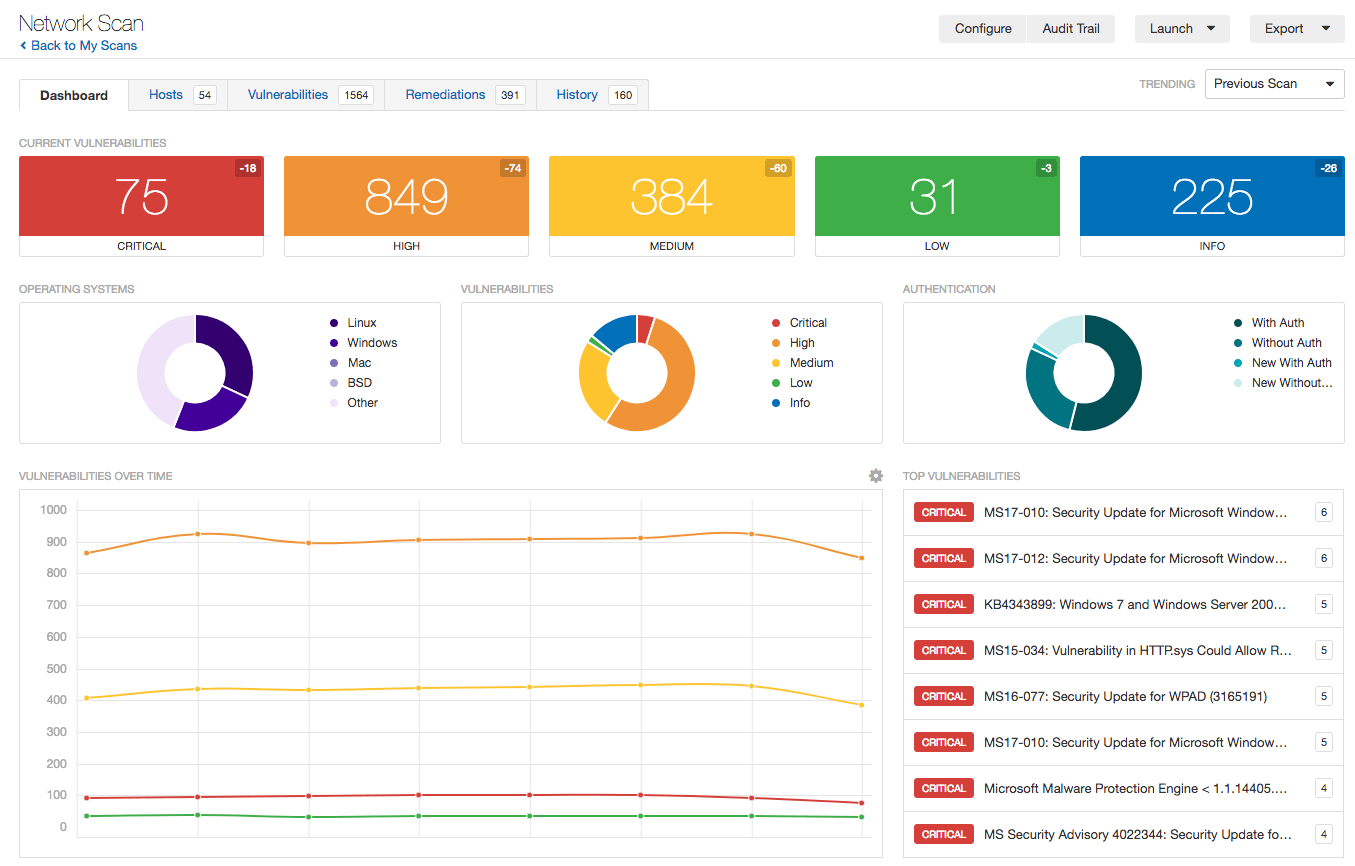
Tenable Nessus helps IT teams find and patch vulnerabilities before hackers can take advantage of them. It’s really good at spotting things like software bugs and configuration mistakes.
Main capabilities
- Advanced vulnerability detection with patch prioritization recommendations.
- Continuous compliance monitoring.
- Integration with security tools.
Cons
- No built-in patching—requires separate tools.
- Higher pricing for enterprise features.
Pricing
Tenable Nessus offers a multi-year pricing plan which starts at $4708.20 per year.
-
NinjaOne
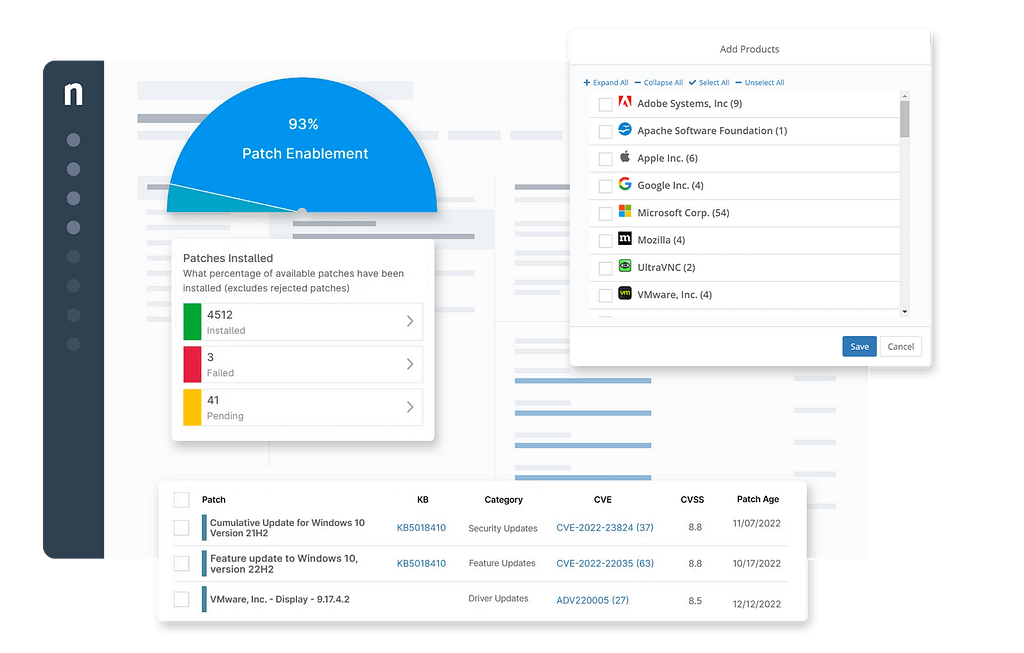
NinjaOne is a unified IT management platform that includes automated patching and remote monitoring. Their solution is cloud, agent-based and helps deploy patches no matter where the endpoints are:
- on-premises
- remote
Main capabilities
- Automated OS & third-party patching.
- Endpoint management and remote control.
- Centralized dashboard for IT admins.
Cons
- Limited reporting features compared to competitors. This could make drawing reports for compliance audits harder and more resource consuming.
- No built-in vulnerability scanning.
I also did not like the reporting and the views in the ticketing system portion of it. For that reason, we took our ticketing to another platform. The views would not always show you what they were supposed to. I would have the option to see all open tickets and it would not show, or show me all closed and it would fail to load them. I had to work out of the all ticket view and that can be quite annoying to have to scroll through all the closed tickets to reach an older opened one.
Pricing
Pricing is quote-based, depending on the number of endpoints.
-
SecOps Solution
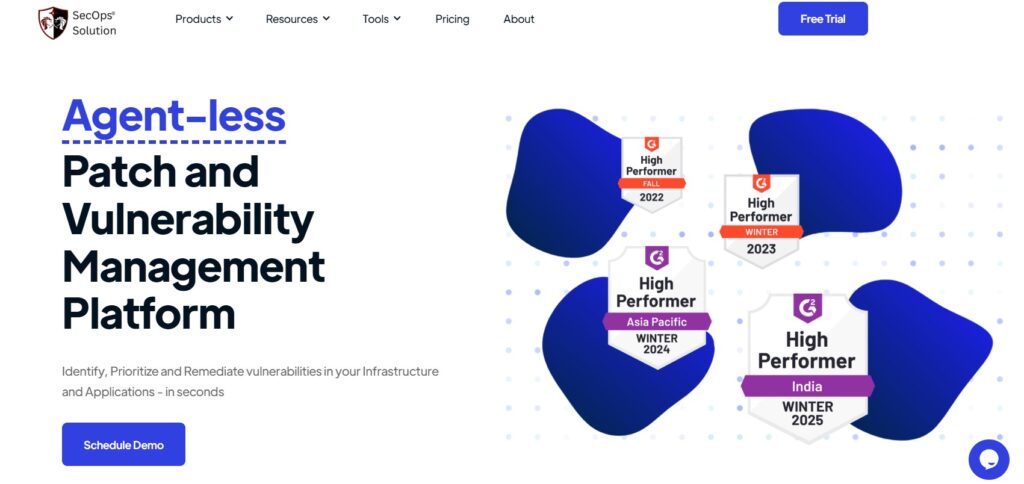
SecOps Solution offers an agent-less, single dashboard patch and vulnerability management platform. It helps scan OSs and 3rd-party apps for vulnerabilities and automates patch management.
Main capabilities
- Patch prioritization based on threat intelligence.
- Tests and sanitizes patches before deployment.
- Compliance enforcement tools.
Cons
- Smaller vendor with limited support resources.
- Steep learning curve.
Pricing
Pricing is tailored to enterprise needs, so you need to ask for a customized offer.
-
Atera

Atera is a cloud-based platform that integrates tools like remote monitoring, helpdesk support, ticketing systems, reporting tools, and IT automation. With Atera, IT pros can monitor and manage their networks and devices from anywhere.
Main capabilities
- Automated patching for Windows & macOS.
- Remote monitoring and IT automation.
- Integration with other security tools like Bitdefender, Cronics, and more.
Cons
- Users say documentation is inaccurate and misleading.
- Some features require additional modules.
The biggest problem with Atera is that their documentation never accurately reflects what our Atera portal looks like. They will update their documentation to include features that are not available to subscribers unless you’re invited by their support. Otherwise, you just have incorrect documentation to reference.
Pricing
Starts at $99 per technician per month.
-
Barracuda RMM
Barracuda RMM is an endpoint security and patch management tool designed for MSPs. Barracuda’s products are quickly deployable and easily managed, ensuring protection without requiring extensive IT resources.
Main capabilities
- Automated patching & vulnerability management.
- Security-first approach with built-in AV.
- Cloud-based management.
Cons
- Can be expensive for smaller teams.
- Limited macOS and Linux support.
Pricing
Pricing is custom, based on endpoints managed.
Choosing the best option for solving patch management in your company is not an easy task. This article helps compare some of the best Patch My PC alternatives.
But you’ll also need to assess your business’ needs. Get a thorough view of your asset inventory, industry specific compliance requirements, the IT team’s profile, budget limits, etc. If you need more inspiration, check this article too – Best Patch Management Software & Tools.
Frequently Asked Questions
Is Patch My PC free?
Patch My PC offers a free version for home users, but business users need a paid license.
What is the best patch management tool?
The best patch management tool depends on your needs:
- operating systems diversity
- endpoints number and diversity
- number and specifics of the third-party apps you use
- in the office, hybrid or remote work environment
- IT team’s resources and skills
- specific compliance requirements
If you need cross-platform support, automated patching, and continuous compliance reporting, Heimdal Patch & Asset Management is an excellent choice.
If you liked this article, follow us on LinkedIn, Twitter, Facebook, and Youtube.










 Network Security
Network Security
 Vulnerability Management
Vulnerability Management
 Privileged Access Management
Privileged Access Management  Endpoint Security
Endpoint Security
 Threat Hunting
Threat Hunting
 Unified Endpoint Management
Unified Endpoint Management
 Email & Collaboration Security
Email & Collaboration Security



